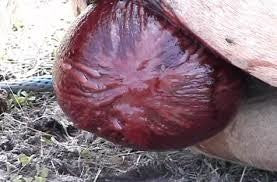Due to the size of this post we have only included the first page below. The full document is available here: Difficult births pdf.
-----------------------------------------------------------------------------------------------------------
A soft jelly-like rump is a great indicator of impending birth because, in all cases, the mares' muscles and birth canal need to relax to allow the foal to pass through.
While we don't like to think about this, sometimes things can go wrong with the pregnancy, and the best thing we can do is be as informed as possible.
We all hope for the best, but we should prepare for the worst.
Some common issues you might face include:
The foal is born sleeping
Here is the exact reason a human needs to be present. Occasionally the foal will be born sleeping and not breathing. It’s important that someone wakes the foal asap.
Firstly make sure the white bag that the foal is in has broken. Clear the foals nostrils and mouth. Rub the foal’s chest vigorously. If that doesn’t work, pinch the inside of the foals nostril or cheek.
Hopefully the foal is just unconscious and not still born.
The bag doesn’t break
Sometimes the bag (amniotic sac) is so thick that it doesn’t break on its own. This is an emergency but hopefully the foal is still alive. Quickly break, tear or cut the sac and make sure the foal starts breathing.
The common theme with all these problems is early detection. Pay close attention to your mare and get to know what "normal" is. Being present at the birth is vital to help correct any problems that may occur. Early intervention often has a successful outcome.
If in doubt, call a VET!
Further reading:
https://www.rossdales.com/assets/files/Dystocia-an-equine-emergency.pdf
http://www.sconeequinehospital.com.au/equine-health-articles/foaling
https://vetmed.illinois.edu/wp-content/uploads/2015/08/13.-Update-on-Equine-Placentitis-in-Mares.pdf
https://onlinelibrary.wiley.com/doi/full/10.1111/eve.12922
http://www.omafra.gov.on.ca/english/livestock/horses/facts/placenta.htm

